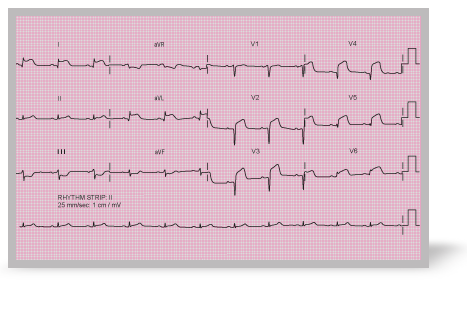
- Question one

Feedback
That’s partly right. Have another go.
Feedback
That’s partly right.
There is a P wave before every QRS complex i.e. sinus rhythm. There is ST elevation across the chest leads (V2 – V6) as well as the lateral limb leads (aVL, I). These findings are consistent with an anterolateral ST elevation myocardial infarction (STEMI). There is no evidence of a bundle branch block (the QRS width is normal).
Feedback
That’s not right. Have another go.
Feedback
That’s not right.
There is a P wave before every QRS complex i.e. sinus rhythm. There is ST elevation across the chest leads (V2 – V6) as well as the lateral limb leads (aVL, I). These findings are consistent with an anterolateral ST elevation myocardial infarction (STEMI). There is no evidence of a bundle branch block (the QRS width is normal).
Feedback
That’s right.
There is a P wave before every QRS complex i.e. sinus rhythm. There is ST elevation across the chest leads (V2 – V6) as well as the lateral limb leads (aVL, I). These findings are consistent with an anterolateral ST elevation myocardial infarction (STEMI). There is no evidence of a bundle branch block (the QRS width is normal).
